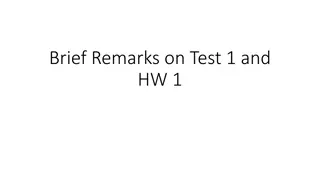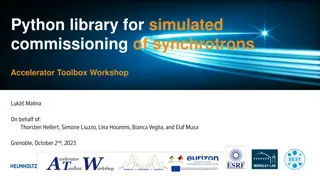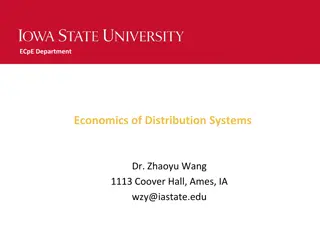Understanding Algorithm Analysis: Key Concepts and Methods
Exploring algorithm analysis through topics like input-output analysis, running time evaluation, experimental studies, limitations, theoretical analysis, pseudocode explanation, and control flow details. Delve into how algorithms perform based on input sizes, types, and different analytical methods used.
Download Presentation
Please find below an Image/Link to download the presentation.
The content on the website is provided AS IS for your information and personal use only. It may not be sold, licensed, or shared on other websites without obtaining consent from the author. Download presentation by click this link. If you encounter any issues during the download, it is possible that the publisher has removed the file from their server.
Presentation Transcript
Fall 2010 Data Structures Lecture 8 Fang Yu Department of Management Information Systems National Chengchi University
Input Algorithm Output Analysis of Algorithms How good is your program?
Running Time Most algorithms transform input objects into output objects. The running time of an algorithm typically grows with the input size. Average case time is often difficult to determine. We focus on the worst case running time. Easier to analyze Crucial to applications such as games, finance and robotics
Experimental Studies Write a program implementing the algorithm Run the program with inputs of varying size and composition Use a method like System.currentTimeMillis() to get an accurate measure of the actual running time Plot the results
Limitations of Experiments It is necessary to implement the algorithm, which may be difficult Results may not be indicative of the running time on other inputs not included in the experiment. In order to compare two algorithms, the same hardware and software environments must be used
Theoretical Analysis Uses a high-level description of the algorithm instead of an implementation Characterizes running time as a function of the input size, n. Takes into account all possible inputs Allows us to evaluate the speed of an algorithm independent of the hardware/software environment
Pseudocode High-level description of an algorithm Example: find max element of an array More structured than English prose AlgorithmarrayMax(A, n) Input array A of n integers Output maximum element of A Less detailed than a program currentMax A[0] fori 1 ton 1 do ifA[i] currentMaxthen currentMax A[i] returncurrentMax Preferred notation for describing algorithms Hides program design issues
Pseudocode Details Control flow if then [else ] while do repeat until for do Indentation replaces braces Method declaration Algorithm method (arg [, arg ]) Input Output
Pseudocode Details Method call var.method (arg [, arg ]) Return value returnexpression Expressions Assignment (like = in Java) = Equality testing (like == in Java) n2 Superscripts and other mathematical formatting allowed
The Random Access Machine (RAM) Model A CPU An potentially unbounded bank of memory cells, each of which can hold an arbitrary number or character 2 1 0 Memory cells are numbered and accessing any cell in memory takes unit time.
Seven Important Functions Seven functions that often appear in algorithm analysis: Constant 1 Logarithmic log n Linear n N-Log-N n log n Quadratic n2 Cubic n3 Exponential 2n
Functions Graphed Using Normal Scale g(n) = n lg n g(n) = 1 g(n) = n2 g(n) = lg n g(n) = 2n g(n) = n g(n) = n3
Primitive Operations Basic computations performed by an algorithm Identifiable in pseudocode Largely independent from the programming language Exact definition not important (we will see why later) Assumed to take a constant amount of time in the RAM model Examples: Evaluating an expression Assigning a value to a variable Indexing into an array Calling a method Returning from a method
Counting Primitive Operations By inspecting the pseudocode, we can determine the maximum number of primitive operations executed by an algorithm, as a function of the input size AlgorithmarrayMax(A, n) operations currentMax A[0] fori 1 ton 1 do ifA[i] currentMaxthen currentMax A[i] { increment counter i } returncurrentMax # 2 2n 2(n 1) 2(n 1) 2(n 1) 1 Total 8n 2
Estimating Running Time Algorithm arrayMax executes 8n 2 primitive operations in the worst case. Define: a = Time taken by the fastest primitive operation b = Time taken by the slowest primitive operation Let T(n) be worst-case time of arrayMax.Then a (8n 2) T(n) b(8n 2) Hence, the running time T(n) is bounded by two linear functions
Growth Rate of Running Time Changing the hardware/ software environment Affects T(n) by a constant factor, but Does not alter the growth rate of T(n) The linear growth rate of the running time T(n) is an intrinsic property of algorithm arrayMax
Why Growth Rate Matters if runtime is... time for n + 1 time for 2 n time for 4 n c lg n c lg (n + 1) c (lg n + 1) c(lg n + 2) c n c (n + 1) 2c n 4c n runtime quadruples when problem size doubles ~ c n lg n + c n 2c n lg n + 2cn 4c n lg n + 4cn c n lg n c n2 ~ c n2 + 2c n 16c n2 4c n2 c n3 ~ c n3 + 3c n2 8c n3 64c n3 c 2n c 2 n+1 c 2 2n c 2 4n
Comparison of Two Algorithms insertion sort is n2 / 4 merge sort is 2 n lg n sort a million items? insertion sort takes roughly 70 hours while merge sort takes roughly 40 seconds This is a slow machine, but if 100 x as fast then it s 40 minutes versus less than 0.5 seconds
Constant Factors The growth rate is not affected by constant factors or lower-order terms 1E+25 Quadratic Quadratic Linear Linear 1E+23 1E+21 1E+19 1E+17 1E+15 T(n) Examples 102n+ +105is a linear function 105n2+ + 108nis a quadratic function 1E+13 1E+11 1E+9 1E+7 1E+5 1E+3 1E+1 1E-1 1E-1 1E+1 1E+3 1E+5 1E+7 1E+9 n
Big-Oh Notation Given functions f(n) and g(n), we say that f(n) is O(g(n)) if there are positive constants c and n0 such that f(n) cg(n) for n n0 10,000 3n 2n+10 1,000 n 100 Example: 2n+10 is O(n) 2n+10 cn (c 2) n 10 n 10 (c 2) Pick c = 3 and n0 = 10 10 1 1 10 100 1,000 n
Big-Oh Example 1,000,000 Example: the function n2is not O(n) n2 cn n c The above inequality cannot be satisfied since c must be a constant n^2 100,000 100n 10n 10,000 n 1,000 100 10 1 1 10 100 1,000 n
More Big-Oh Example 7n-2 is O(n) need c > 0 and n0 1 such that 7n-2 c n for n n0 this is true for c = 7 and n0 = 1 3n3 + 20n2 + 5 is O(n3) need c > 0 and n0 1 such that 3n3 + 20n2 + 5 c n3 for n n0 this is true for c = 4 and n0 = 21 3 log n + 5 is O(log n) need c > 0 and n0 1 such that 3 log n + 5 c log n for n n0 this is true for c = 8 and n0 = 2
Big-Oh and Growth Rate The big-Oh notation gives an upper bound on the growth rate of a function The statement f(n) is O(g(n)) means that the growth rate of f(n) is no more than the growth rate of g(n) We can use the big-Oh notation to rank functions according to their growth rate f(n) is O(g(n)) g(n) is O(f(n)) g(n) grows more f(n) grows more Same growth Yes No Yes No Yes Yes
Big-Oh Rules If f(n) is a polynomial of degree d, then f(n) is O(nd), i.e., 1.Drop lower-order terms 2.Drop constant factors Use the smallest possible class of functions Say 2n is O(n) instead of 2n is O(n2) Use the simplest expression of the class Say 3n+5 is O(n) instead of 3n+5 is O(3n)
Asymptotic Algorithm Analysis The asymptotic analysis of an algorithm determines the running time in big-Oh notation To perform the asymptotic analysis We find the worst-case number of primitive operations executed as a function of the input size We express this function with big-Oh notation
Asymptotic Algorithm Analysis Example: We determine that algorithm arrayMax executes at most 8n 2 primitive operations We say that algorithm arrayMax runs in O(n) time Since constant factors and lower-order terms are eventually dropped anyhow, we can disregard them when counting primitive operations
Computing Prefix Averages We further illustrate asymptotic analysis with two algorithms for prefix averages 35 X A 30 25 The i-th prefix average of an array X is average of the first (i+ 1) elements of X: 20 15 A[i]= (X[0] +X[1] + +X[i])/(i+1) 10 5 Computing the array A of prefix averages of another array X has applications to financial analysis 0 1 2 3 4 5 6 7
Prefix Average (Quadratic) The following algorithm computes prefix averages in quadratic time by applying the definition AlgorithmprefixAverages1(X, n) Input array X of n integers Output array A of prefix averages of X A new array of n integers fori 0 ton 1 do s X[0] forj 1 toido s s+X[j] A[i] s (i+ 1) returnA #operations n n 1 + 2 + + (n 1) 1 + 2 + + (n 1) n 1 n
Arithmetic Progression The running time of prefixAverages1 is O(1 + 2 + + n) The sum of the first n integers is n(n+ 1) 2 There is a simple visual proof of this fact Thus, algorithm prefixAverages1 runs in O(n2) time
Prefix Average (Linear) The following algorithm computes prefix averages in linear time by keeping a running sum Algorithm prefixAverages2 runs in O(n) time AlgorithmprefixAverages2(X, n) Input array X of n integers Output array A of prefix averages of X #operations A new array of n integers s 0 fori 0 ton 1 do s s+X[i] A[i] s (i+ 1) returnA n 1 n n 1 n
Relatives of Big-Oh big-Omega f(n) is (g(n)) if there is a constant c > 0 and an integer constant n0 1 such that f(n) c g(n) for n n0 big-Theta f(n) is (g(n)) if there are constants c > 0 and c > 0 and an integer constant n0 1 such that c g(n) f(n) c g(n) for n n0
Intuition for Asymptotic Notation Big-Oh f(n) is O(g(n)) if f(n) is asymptotically less than or equal to g(n) big-Omega f(n) is (g(n)) if f(n) is asymptotically greater than or equal to g(n) big-Theta f(n) is (g(n)) if f(n) is asymptotically equal to g(n)
Examples of Using Relatives of Big-Oh 5n2 is (n2) f(n) is (g(n)) if there is a constant c > 0 and an integer constant n0 1 such that f(n) c g(n) for n n0 let c = 5 and n0 = 1 5n2 is (n) f(n) is (g(n)) if there is a constant c > 0 and an integer constant n0 1 such that f(n) c g(n) for n n0 let c = 1 and n0 = 1 5n2 is (n2) f(n) is (g(n)) if it is (n2) and O(n2). We have already seen the former, for the latter recall that f(n) is O(g(n)) if there is a constant c > 0 and an integer constant n0 1 such that f(n) < c g(n) for n n0 Let c = 5 and n0 = 1
HW 8 Project Proposal due on Nov. 11! We don t have programming HW this week! Remember to bring a hardcopy of your project proposal to the class next week Also submit your project proposal file to your TAs Discuss potential difficulties of your project We can select some topics and explain in the lab
HW Review Lets review all the HW

















































